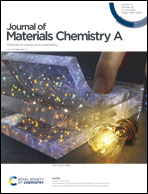Metallic 1T-MoS2 coupled with MXene towards ultra-high rate-capabilities for supercapacitors†
Abstract
Metallic 1T-phase MoS2 (1T-MoS2) nanosheets with large interlayer spacing are considered to be a high-energy electrode material for use in supercapacitors; however, the electrochemical storage mechanism of 1T-MoS2 involves ion intercalation, resulting in energy storage being limited at high current densities and showing poor rate capability. Here, a 1T-MoS2/Ti3C2Tx heterostructure was assembled from metallic 1T-MoS2 nanosheets coupled with a Ti3C2 MXene through one-pot hydrothermal synthesis, and the electrochemical storage mechanisms were investigated. The electrochemical advantages of 1T-MoS2 and Ti3C2Tx can be united via synergistic interplay in the heterostructure. The high specific capacitance is attributed to the metallic properties and the large interlayer spacing of the 1T-MoS2 component. More importantly, ultra-high rate capability is realized due to fast electron and ion transport originating from Ti3C2Tx. In addition, an all-solid-state flexible asymmetric aqueous supercapacitor (FASC) constructed with 1T-MoS2/Ti3C2Tx as the negative electrode and δ-MnO2 as the positive electrode shows a wide potential window of 1.8 V and a high areal energy density of 68.8 μW h cm−2 at 4500 μW cm−2. This work will provide a reference for studying electrochemical storage mechanisms in heterostructures, and it demonstrates the promise of the 1T-MoS2/MXene heterostructure for supercapacitor use.



 Please wait while we load your content...
Please wait while we load your content...